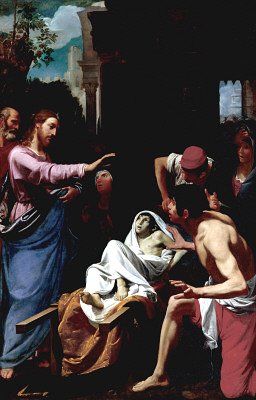 |
|
Christ Raising the Son of the Widow of Nain
Domenico Fiasella, Italian 1589-1669
SN 112, Oil on Canvas 1615
by Robert Anderson.
Artist:
This artist, called Il Sarzana, was born in 1589 in Sarzana, where he started studying art
at age eleven. He soon went to Rome where he stayed for about a decade. It was in Rome
that he became acquained with the Caravaggesque realism trends in painting. Between 1616
and 1618 he went to Genoa where he settled and enjoyed a long career. Fiasella painted
frescos as well as oil paintings - religious scenes primarily. His work shows a response
to the robust figure style, painterly surfaces and brilliant reds and golds of Rubens and
Van Dyke. The clarity, detail, color and classical figures in Fiasella's early
compositions continued in his paintings of the 1620's. From 1630 on, painting in Genoa was
dominated by Fiasella and his workshop. He continued active until 1667 and was most
prolific in later years with a Baroque vigour inspired by Castiglione.
Fiasella had a large workshop and his school provided a place for such
artists as Pierre Puget and Castiglione to exchange ideas. His talent as a teacher can be
seen in the quality of his many students to whom he transmitted his knowledge of Rubens
and Van Dyke. The naturalistic drawings of heads by his pupils attest to Fiasella's
expertise in portraiture and his monumental figures and smooth, closed brushstrokes differ
sharply from the painterly, neo-Venetian art of his Genoese contempoaries. |
Subject:
New Testament - Luke 7 : 11-16. And it came to pass the day after, that he went into a
city called nain; and many of his disciples went with him, and much people. Now when he
came nigh to the gate of the city, behold, there was a dead man carried out, the only son
of his mother, and she was a widow : and much people of the city was with her. And when
the Lord saw her, he had compassion on her, and said unto her, Weep not.
And he came and touched the bier : and they that bear him stood still. And he said, Young
man, I say unto thee, Arise. And he that was dead sat up,and began to speak. And
he delivered him to his mother.
Painting:
This painting along with its companion, Christ Healing the Blind, also exhibited in this
gallery was originally thought to be by one or another of the Carracci. After a century
and a half it has finally been identified as a painting by Domenico Fiasella.
Such large paintings, both concerned with healing, were probably
commissioned for the chapel of a hospital - the most obvious being that attached to Saint
Giovanni de Genovesi, the Genoese church in Rome.
This painting and the one on the opposite wall were probably originally
hung on side altars in a chapel. Their placement in the narrow space of this gallery was
done intentionally and suggests the way such side altars were originally seen by church
goers receiving communion.
The figures appear flat and distorted when seen from the front but acquire
a surprising three dimensionsl appearance when viewed from a forty-five degree angle -
best viewed at mid gallery between the doors.
The figures are monumental and show a robustness and color which are
reminiscent of Rubens and Vandyke. A Baroque vigor can be noted in the naturalness and
outward thrust of the bodies which was inspired by Castiglione and by Caravaggio's famous
altarpieces painted in Rome in the 1600's.
Historical Context:
This painting and its companion were painted in 1615 at a time when art had become a major
form of propaganda for the Catholic faith in the Baroque period. It was an especially
important weapon in the Catholic Church's fight against Protestantism, known as the
Counter Reformation.
The arts thus became increasingly an integral part of meditation and
devotion. Scenes of miracles and martyrdom were among the most popular subjects both
because they proved the power of faith and because their awe inspiring and emotional
nature was a challenge that Baroque art was most suited to meet. |
